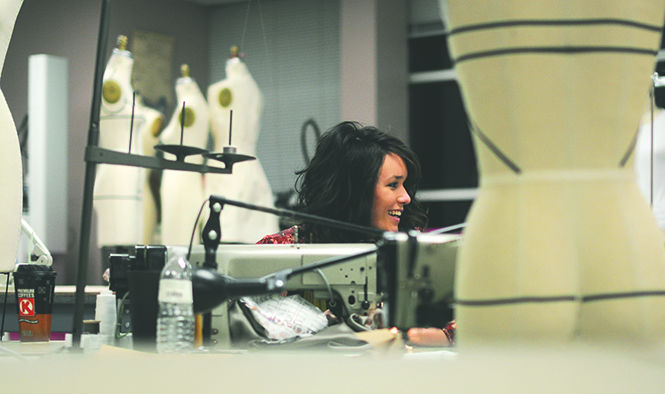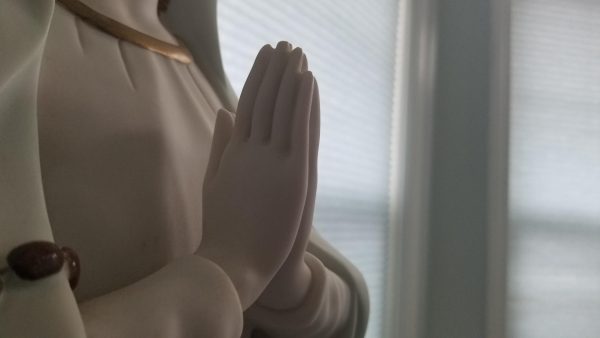Stressful majors across campus
Jade Synder, senior fashion design major, laughs with her friend while lining a top in Rockwell Hall on Feb. 19, well after midnight. Photo by Jacob Byk.
February 21, 2013
While every student may feel overwhelmed by his or her courses, certain majors are considered to be some of the most stressful on campus. The reasoning varies from financial stress to the level of difficulty of the required courses.
“Stress depends on the individual,” said Deanna Donaugh, academic adviser at the exploratory advising center. “And sometimes the class.”
Nursing
Kent State’s nursing program is one of the most competitive on campus.
According to Curtis Good, director of academic and student services in the College of Nursing, the requirements are a bit tough and can be the cause of stress for students in the major.
The following are the most stressful majors on campus, according to Deanna Donaugh, academic adviser for the exploratory advising center:
- Nursing
- Architecture
- Education
- Visual Communication Design
- Art
- Fashion
- Theater
- Aeronautics
- Athletic Training
Good said the major requires the standard 2.7 minimum overall GPA and 30 credit hours to apply to get into the program. There are a set number of spots, and students with the highest GPAs are accepted first.
“Many of the classes require you to have a 75 percent to pass,” sophomore nursing major Karla Santiago said. “If you don’t pass, then you have to retake the class.”
In their first year, nursing students must take four critical science classes in addition to their Kent Core classes before they are officially in the program.
Santiago said that it’s not just the types of classes, but the combination of labs, clinicals and two-hour lectures that can be stressful. She said one of the challenges she’s faced has been changing the way she thinks and retains information.
“You really have to think critically and think outside of the box,” Santiago said. “I’ve always been more of a ‘learn and apply’ type of person, so I had to change to think more critically.”
She said the major can also put a financial stress on students. The Assessment Technologies Institute (ATI) testing students must take costs several hundred of dollars. Uniforms and shoes nursing students need to purchase cost around $200.
“In the beginning I felt the financial stress,” Santiago said. “During the summer, I felt like I kept working and working, and all my money just went to nursing. But it’s not as bad now.”
The Self-Care Institute, located in Henderson Hall, is a fairly new addition to campus that is designed to help nursing students reduce stress.
Michelle Bozeman, outreach program coordinator for the College of Nursing, said the institute also welcomes students from all majors.
“The idea is that nursing as a student or nurse is highly stressful, not just academically, but also the stress of caring for people,” Bozeman said.
The institute has offered massages, yoga and relaxing music, and it has a mobile app and website that provide resources for student to manage stress, anxiety and insomnia.
“We want students to experience success, and when we’re balanced that helps,” Bozeman said.
Architecture
According to Charles Harker, associate architecture professor, the architecture major has the highest entrance requirements on campus. Because of its competitive nature, it can put added pressure on students in the program.
Students are required to receive a 25 on their ACTs, have a 3.0 high school GPA and be in the top 20 percent of their graduating class.
“We usually have anywhere between 500 and 600 applications, and we take the top 100,” Harker said.
Students said getting accepted into the program isn’t the only stressful part about the major. The workload and long hours spent on projects can cause added stress.
“It’s non-stop,” said Alexander Wills, freshman architecture major. “For some people the weekend means they get to go out, but for us it just means another project.”
Kaitlyn Kough, sophomore interior design major, said that she finds the major stressful because she feels that the teachers give a lot of work and expect it to be completed in a short amount of time.
“I don’t have an art background, and in the first year the work is more artsy,” Kough said. “I was just thrown in.”
Meghan Jenkins, freshman interior design major, said the major is more difficult because the courses aren’t as traditional.
“It’s a different type of thinking,” Jenkins said. “You can’t memorize things; you have to create.”
Both Kough and Jenkins said the major doesn’t cause financial stress, but they agree that things add up. Kough said she constantly has to buy glue for her projects, which costs nearly $10 for a one-ounce bottle. She said she estimates she’s spent more than $100 on materials alone.
“Instead of spending money on supplies, that is money that could be spent going out to eat,” Jenkins said.
Harker said the major requires a lot of hard work and dedication. Although students often pull all-nighters, he said it is minimized by the fourth year because students have learned to manage their time better.
“I’ve had students who have never pulled an all-nighter,” Harker said. “One way to not pull an all-nighter is to sit in the studio and just work.”
Education
According to Joanne Arhar, associate dean of education, the education major can be stressful in a number of ways, including all the requirements students must pass to be qualified to teach.
Over the next four years in the major, there are several checkpoints to test the students, including exams, assessments, interviews and prerequisite training.
Before education majors can work in a school as a student teacher, they must take Praxis tests in reading, writing and math and pass the cut scores.
Student must also have ALICE training, which provides teachers child safety training, basic life training and how to handle emergencies, such as a school shooting, before they can become a student teacher.
“Teaching is a difficult profession,” Arhar said. “We have high standards for our students, and the government has high standards as well.”
She said principals and schools also hold potential teachers to high standards, and students are finding it more difficult to find student teaching positions.
“More and more [schools] don’t want to take student teachers,” Arhar said. “Some have to travel up to 50 miles to get to work.”
Arhar also said that once students graduate, there can be 200 to 300 people applying for one position.
In addition to the requirements, Arhar said the major can also place a financial burden on students. Students are required to pay for their training, as well as a blind review of their portfolio by Pearson Education.
Arhar said Kent State’s Education Department tries to help students deal with the stress as much as possible.
“Our faculty really goes out of the way to help our students,” Arhar said.
She said the classes average about 25 students, and some of the programs have students progress through the program as a cohort, meaning they stay with the same classmates. She said this allows students to help one another succeed.
Fine Arts
Mark Schatz, assistant professor of art, said that there are two kinds of stress that affect art majors: overload stress and excitement stress.
“Good art takes a lot of time,” Schatz said.
He said overload stress is all about finding balance and managing time wisely.
Schatz said the excitement stress comes when students begin to feel anxiety about presenting their portfolios to faculty. He said it is the anxiety of being vulnerable that worries students.
“Students get worked up about it, but that’s good,” Schatz said. “It’s like a piano recital; you’ll practice and polish a lot harder if you have to present in front of someone.”
Some students, like Shelby Driver, sophomore crafts major, said the stress isn’t so bad.
“It is stressful, but it’s worth it because I love it,” Driver said.
Schatz said every student is assigned to a faculty mentor who can help see him or her through the requirements and help ease stress.
He said the tools and supplies needed can get expensive for art students, but once they are purchased, students can use them for a long time. Schatz said he is still using the tools he purchased when he was an undergraduate.
Crystal Roe, employee at All Media Art Supply Company, said she sees Kent State art students come in frequently to purchase supplies. Most of the time students spent between $20 to $30.
“They come in every couple weeks,” Roe said. “They’re all that shops here.”
Nathaniel Maloney, senior fine arts major, said the costs can add up when buying supplies, but faculty try to help students any way they can.
“Instructors try to guide you to the least expensive option,” Maloney said. “They realize that we’re struggling college students.”
In addition to the financial burden of supplies and tools, Schatz also said that there are no guarantees for a job after graduation for art majors. He said these students are the type capable of making their own way and don’t need guarantees.
“Students leave here and jump into the flames of reality,” Schatz said. “But these students can make magic with whatever.”
Visual Communication Design
Brendon Roberto, senior visual communication design major, said there are several checkpoints throughout the program that visual communication design majors must complete.
Certain checkpoints, such as VCD studio, require students to earn at least a B to pass. If students don’t pass the first time, they must take the course a second time. If a student fails to pass the second time, they are required to change their major.
He said another stressful part of the major is that student projects are created in front of others, and that includes both good work and bad.
“If you’re struggling, then everyone knows,” Roberto said. “Everyone is really supportive, though.”
Roberto said the cost of the major can add up as well because students have to pay to print their projects at places such as Kinko’s, as well as pay for their materials.
“If you mess up, you have to start over and pay for the materials again,” Roberto said. “Then you wasted all that time and money.”
Roberto, who estimates he’s already spent more than $250 on supplies and printing so far this semester, said the tradeoff is that his classes don’t usually require textbooks, so he doesn’t have to factor in those costs.
He said the best resource to help deal with the stress is to speak with professors and let them know why you are stressed out.
“If you are having trouble, but you aren’t going to your professor for help, they are going to take that as a sign that you don’t care,” Roberto said. “The key is to communicate.”
Aeronautics
The aeronautics major is one that puts a significant financial strain on students.
Joshuae Murphy, sophomore aeronautics major, said he didn’t get his extra financial aid until shortly before the semester began.
Murphy said students in his major have to pay an extra $9 thousand per semester for flight training.
“You have to pay for each hour you are going to fly the plane,” Murphy said. “You have to stay on top of things, otherwise the instructor will think you aren’t ready, and you will have to pay for more hours.”
Murphy said aeronautics majors are also required to pass a pilot physical, as well as a drug test, in addition to their courses.
Kirsten Bowers

























